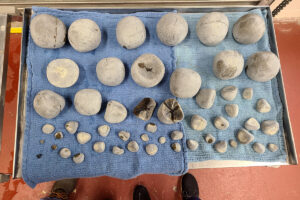The Incidence of Colic
- Topics: American Paint Horse, Appaloosa, Article, Colic, Standardbred, Thoroughbred
Most horses that experience colic do not usually reach the point where the cycle cannot be broken. Indeed, the vast majority of colic episodes resolve with no or minimal veterinary intervention.
The incidence of equine colic has been estimated by the USDA’s National Animal Health Monitoring System (NAHMS) Equine 1998 study at 4.2 events per 100 horses per year. This health monitoring system was designed to outline the overall prevalence and occurrence of various types of disease within the North American horse population.
The 1998 study found no difference in the incidence of colic among geographic regions. The percentage of equine operations that experienced one or more colic events was 16.3. Overall, only 1.4% of colic events resulted in surgical intervention.
Colic at a Glance
- Colic means abdominal pain. It is not a specific diagnosis.
- The intestine can twist or become trapped in areas it does not belong.
- A number of risk factors are associated with increased incidence of colic, including a history of colic, changes in feeding programs, poor parasite control, and poor dental care.
The fatality rate for all colic events was 11%. In this same report neither gender nor use of horse was associated with the incidence of colic. There does, however, appear to be some association between some types of colic and gender. For instance, uterine torsion and scrotal herniation would be expected to be gender specific. Furthermore, colonic torsion (twisting of the large intestine) appears to be more prevalent in mares. Nonetheless, gender is not consistently a factor that affects incidence of other causes of colic
Create a free account with TheHorse.com to view this content.
TheHorse.com is home to thousands of free articles about horse health care. In order to access some of our exclusive free content, you must be signed into TheHorse.com.
Start your free account today!
Already have an account?
and continue reading.

Related Articles
Stay on top of the most recent Horse Health news with

















